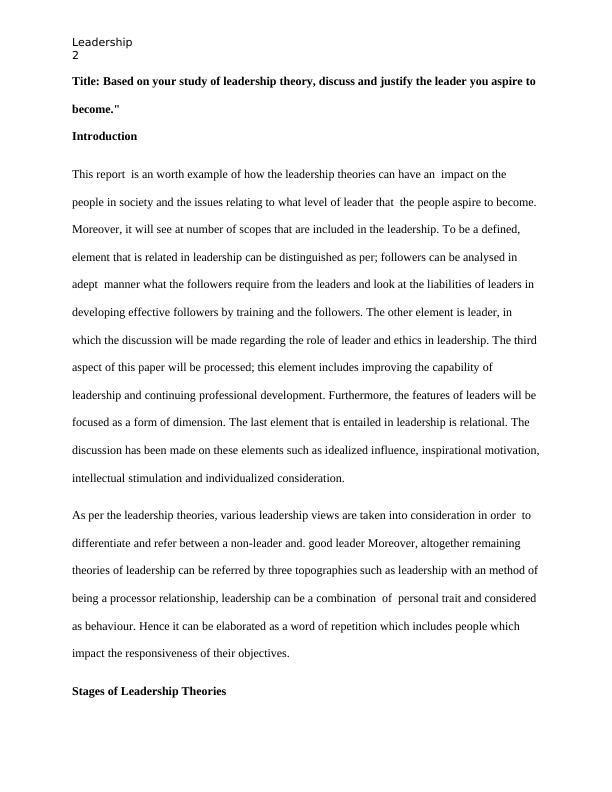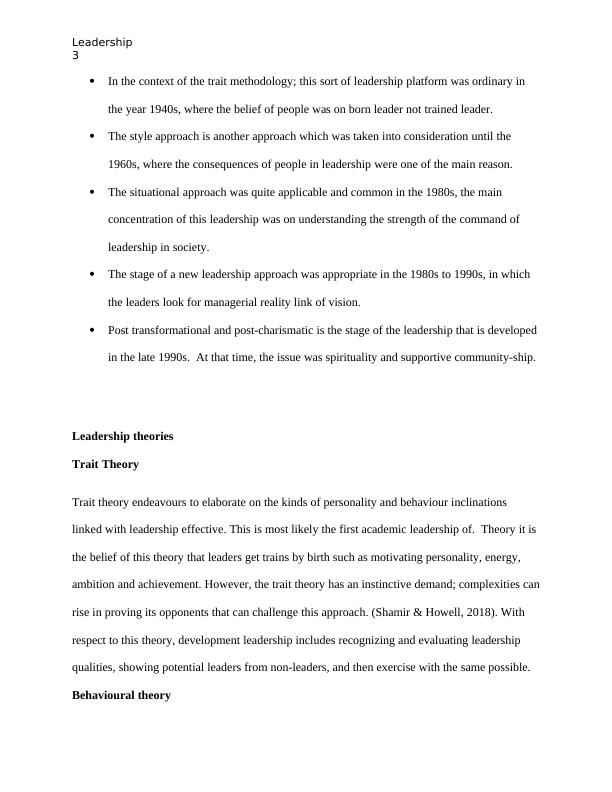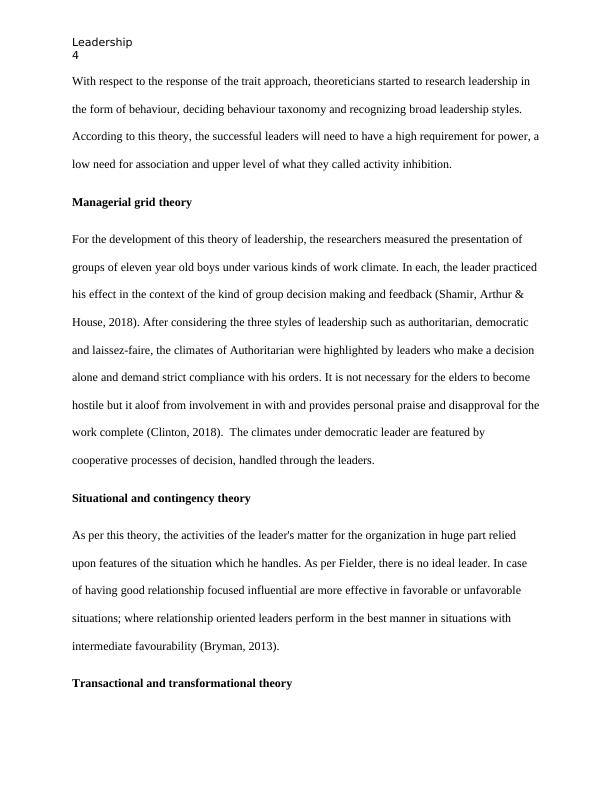Leadership in Contemporary Organisations
Added on 2023-01-10
18 Pages4824 Words2 Views
Leadership
1
Leadership in Contemporary Organisations
1
Leadership in Contemporary Organisations

Leadership
2
Title: Based on your study of leadership theory, discuss and justify the leader you aspire to
become."
Introduction
This report is an worth example of how the leadership theories can have an impact on the
people in society and the issues relating to what level of leader that the people aspire to become.
Moreover, it will see at number of scopes that are included in the leadership. To be a defined,
element that is related in leadership can be distinguished as per; followers can be analysed in
adept manner what the followers require from the leaders and look at the liabilities of leaders in
developing effective followers by training and the followers. The other element is leader, in
which the discussion will be made regarding the role of leader and ethics in leadership. The third
aspect of this paper will be processed; this element includes improving the capability of
leadership and continuing professional development. Furthermore, the features of leaders will be
focused as a form of dimension. The last element that is entailed in leadership is relational. The
discussion has been made on these elements such as idealized influence, inspirational motivation,
intellectual stimulation and individualized consideration.
As per the leadership theories, various leadership views are taken into consideration in order to
differentiate and refer between a non-leader and. good leader Moreover, altogether remaining
theories of leadership can be referred by three topographies such as leadership with an method of
being a processor relationship, leadership can be a combination of personal trait and considered
as behaviour. Hence it can be elaborated as a word of repetition which includes people which
impact the responsiveness of their objectives.
Stages of Leadership Theories
2
Title: Based on your study of leadership theory, discuss and justify the leader you aspire to
become."
Introduction
This report is an worth example of how the leadership theories can have an impact on the
people in society and the issues relating to what level of leader that the people aspire to become.
Moreover, it will see at number of scopes that are included in the leadership. To be a defined,
element that is related in leadership can be distinguished as per; followers can be analysed in
adept manner what the followers require from the leaders and look at the liabilities of leaders in
developing effective followers by training and the followers. The other element is leader, in
which the discussion will be made regarding the role of leader and ethics in leadership. The third
aspect of this paper will be processed; this element includes improving the capability of
leadership and continuing professional development. Furthermore, the features of leaders will be
focused as a form of dimension. The last element that is entailed in leadership is relational. The
discussion has been made on these elements such as idealized influence, inspirational motivation,
intellectual stimulation and individualized consideration.
As per the leadership theories, various leadership views are taken into consideration in order to
differentiate and refer between a non-leader and. good leader Moreover, altogether remaining
theories of leadership can be referred by three topographies such as leadership with an method of
being a processor relationship, leadership can be a combination of personal trait and considered
as behaviour. Hence it can be elaborated as a word of repetition which includes people which
impact the responsiveness of their objectives.
Stages of Leadership Theories

Leadership
3
In the context of the trait methodology; this sort of leadership platform was ordinary in
the year 1940s, where the belief of people was on born leader not trained leader.
The style approach is another approach which was taken into consideration until the
1960s, where the consequences of people in leadership were one of the main reason.
The situational approach was quite applicable and common in the 1980s, the main
concentration of this leadership was on understanding the strength of the command of
leadership in society.
The stage of a new leadership approach was appropriate in the 1980s to 1990s, in which
the leaders look for managerial reality link of vision.
Post transformational and post-charismatic is the stage of the leadership that is developed
in the late 1990s. At that time, the issue was spirituality and supportive community-ship.
Leadership theories
Trait Theory
Trait theory endeavours to elaborate on the kinds of personality and behaviour inclinations
linked with leadership effective. This is most likely the first academic leadership of. Theory it is
the belief of this theory that leaders get trains by birth such as motivating personality, energy,
ambition and achievement. However, the trait theory has an instinctive demand; complexities can
rise in proving its opponents that can challenge this approach. (Shamir & Howell, 2018). With
respect to this theory, development leadership includes recognizing and evaluating leadership
qualities, showing potential leaders from non-leaders, and then exercise with the same possible.
Behavioural theory
3
In the context of the trait methodology; this sort of leadership platform was ordinary in
the year 1940s, where the belief of people was on born leader not trained leader.
The style approach is another approach which was taken into consideration until the
1960s, where the consequences of people in leadership were one of the main reason.
The situational approach was quite applicable and common in the 1980s, the main
concentration of this leadership was on understanding the strength of the command of
leadership in society.
The stage of a new leadership approach was appropriate in the 1980s to 1990s, in which
the leaders look for managerial reality link of vision.
Post transformational and post-charismatic is the stage of the leadership that is developed
in the late 1990s. At that time, the issue was spirituality and supportive community-ship.
Leadership theories
Trait Theory
Trait theory endeavours to elaborate on the kinds of personality and behaviour inclinations
linked with leadership effective. This is most likely the first academic leadership of. Theory it is
the belief of this theory that leaders get trains by birth such as motivating personality, energy,
ambition and achievement. However, the trait theory has an instinctive demand; complexities can
rise in proving its opponents that can challenge this approach. (Shamir & Howell, 2018). With
respect to this theory, development leadership includes recognizing and evaluating leadership
qualities, showing potential leaders from non-leaders, and then exercise with the same possible.
Behavioural theory

Leadership
4
With respect to the response of the trait approach, theoreticians started to research leadership in
the form of behaviour, deciding behaviour taxonomy and recognizing broad leadership styles.
According to this theory, the successful leaders will need to have a high requirement for power, a
low need for association and upper level of what they called activity inhibition.
Managerial grid theory
For the development of this theory of leadership, the researchers measured the presentation of
groups of eleven year old boys under various kinds of work climate. In each, the leader practiced
his effect in the context of the kind of group decision making and feedback (Shamir, Arthur &
House, 2018). After considering the three styles of leadership such as authoritarian, democratic
and laissez-faire, the climates of Authoritarian were highlighted by leaders who make a decision
alone and demand strict compliance with his orders. It is not necessary for the elders to become
hostile but it aloof from involvement in with and provides personal praise and disapproval for the
work complete (Clinton, 2018). The climates under democratic leader are featured by
cooperative processes of decision, handled through the leaders.
Situational and contingency theory
As per this theory, the activities of the leader's matter for the organization in huge part relied
upon features of the situation which he handles. As per Fielder, there is no ideal leader. In case
of having good relationship focused influential are more effective in favorable or unfavorable
situations; where relationship oriented leaders perform in the best manner in situations with
intermediate favourability (Bryman, 2013).
Transactional and transformational theory
4
With respect to the response of the trait approach, theoreticians started to research leadership in
the form of behaviour, deciding behaviour taxonomy and recognizing broad leadership styles.
According to this theory, the successful leaders will need to have a high requirement for power, a
low need for association and upper level of what they called activity inhibition.
Managerial grid theory
For the development of this theory of leadership, the researchers measured the presentation of
groups of eleven year old boys under various kinds of work climate. In each, the leader practiced
his effect in the context of the kind of group decision making and feedback (Shamir, Arthur &
House, 2018). After considering the three styles of leadership such as authoritarian, democratic
and laissez-faire, the climates of Authoritarian were highlighted by leaders who make a decision
alone and demand strict compliance with his orders. It is not necessary for the elders to become
hostile but it aloof from involvement in with and provides personal praise and disapproval for the
work complete (Clinton, 2018). The climates under democratic leader are featured by
cooperative processes of decision, handled through the leaders.
Situational and contingency theory
As per this theory, the activities of the leader's matter for the organization in huge part relied
upon features of the situation which he handles. As per Fielder, there is no ideal leader. In case
of having good relationship focused influential are more effective in favorable or unfavorable
situations; where relationship oriented leaders perform in the best manner in situations with
intermediate favourability (Bryman, 2013).
Transactional and transformational theory

End of preview
Want to access all the pages? Upload your documents or become a member.
Related Documents
Leadership in the Catering Industrylg...
|9
|1674
|21
Leadership Theories Assignment (Doc)lg...
|3
|728
|58
Leadership in Organizations: Essaylg...
|10
|2549
|67
Authentic Leadership and Psychological Capitallg...
|11
|3078
|426
Report on Effective Organizational Behaviour Pdflg...
|13
|3663
|204
The Behaviour Theory of Leadershiplg...
|1
|791
|104
